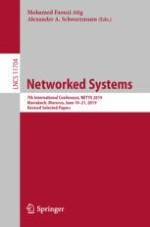2019 | Book
Networked Systems
7th International Conference, NETYS 2019, Marrakech, Morocco, June 19–21, 2019, Revised Selected Papers
Editors: Mohamed Faouzi Atig, Prof. Alexander A. Schwarzmann
Publisher: Springer International Publishing
Book Series : Lecture Notes in Computer Science
